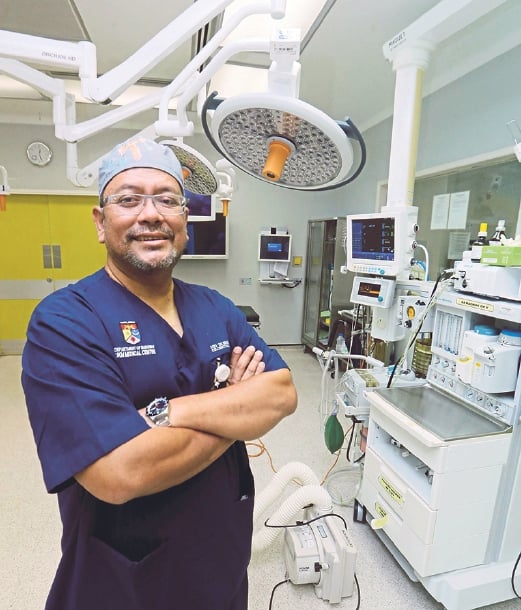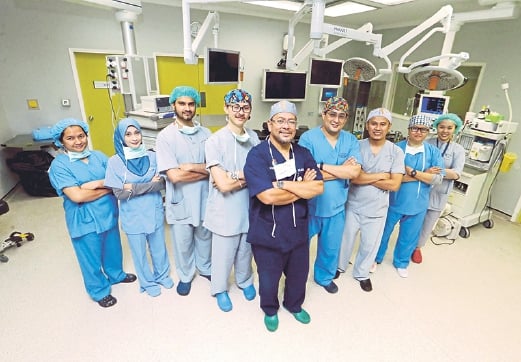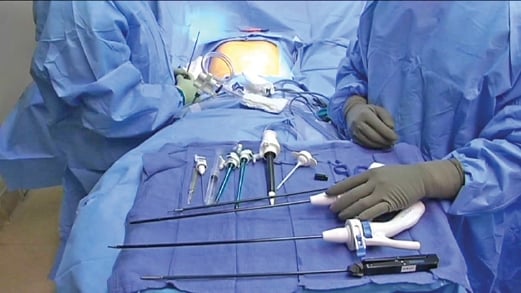Universiti Kebangsaan Malaysia Medical Centre is transforming its operating rooms into smart and cutting-edge facilities, writes Hanna Sheikh Mokhtar
PRIOR to my interview with associate professor Datuk Dr Ismail Sagap, senior lecturer and senior consultant surgeon at Universiti Kebangsaan Malaysia Medical Centre (UKMMC), I received a message from him on Whatsapp that read: “I’m at the second floor OT (Operating Theatre). Be prepared to enter the OT for the interview. You will need to put on OT attire, etc.”
I was excited to hear this as I had been in hospital OTs several times, but always as a patient. As I was fully sedated on all occasions, I was unaware of what went on in the OT during the surgical procedures.
BIG ON IMPRESSION
The OT is almost second home to Ismail, who spends most of his time supervising, tutoring and teaching student doctors, as well as practising doctors, about a specialised surgical method known as minimally invasive surgery, or keyhole surgery. In the case of stomach surgery, it is known as laparoscopic surgery.
Ismail, head of the Endoscopy Service Centre, has been with UKMMC since 2001. Along with two other surgeons from the hospital, he was awarded the Fellowship of the Royal College Of Surgeons (FRCS) of Edinburgh in 2014. This long established professional qualification allows a surgeon to practise as a senior surgeon in Ireland or the United Kingdom, bestowed by the Royal College of Surgeons of England, Ireland, Edinburgh, and Glasgow.
Ismail is a specialist in general and colorectal surgery and with his vast knowledge and skills, has been training doctors from Malaysia and around the world in the field of laparoscopy and endoscopy.
As I stepped into a surgical observation gallery in one of UKMMC’s OT rooms, I watched as a young patient of about 6 or 7 years was wheeled into the state-of-the-art, fully-integrated high-definition operating theatre dubbed OR1. The observation gallery had wide windows overlooking the OR1, so I could see everything that was going on inside the operating room.
STATE-OF-THE-ART FACILITIES
There are 20 operating rooms in UKMMC, two of which are OR1 types. These are operating rooms equipped with the most modern facilities, such as diagnostic imaging equipment to guide surgical procedures, with computer-controlled navigation systems as an integral component.
The OR1 in UKMMC is equipped with a time-out and checklist system making it the first high-tech operating theatre in the country with improved safety features, one of the first in the world too!
The high-tech facilities in the OR1 allow surgeons to perform difficult and complex endoscopic and laparoscopic surgery on kidneys, pancreas, uterus and colon with improved patient outcomes at a lower overall cost than is currently available with conventional open surgeries.
“Doctors coming into the field are now being taught this ground-breaking technique where the outcomes are significantly two to three times better compared with conventional open surgery — in terms of faster recovery time, and not much pain during and after surgery, resulting in better quality of life for patients,” said Ismail.
The numerous LCD flat screen monitors placed around the bed and room serve many uses. Support staff and medical students can use the monitors to watch an operation without having to lean over the surgeon to see the procedure. The monitors help the anaesthesiologist track how the patient is doing. Besides showing the patient’s vital signs, the surgical team can call up the patient’s X-rays, MRI, or CAT scans on the screen from other departments in the hospital.
The beauty of the OR1 is in how it enables a surgeon to do most of the work himself, such as controlling the room and overhead lights, merely by touching a computer screen. This helps cut down on the surgeon’s reliance on many support staff and makes the operation theatre less crowded. Consequently, this also helps increase the overall efficiency of the patient’s treatment and reduces trauma as well as costs.
UKMMC’s OR1 also comes with video conferencing equipment and facilities, enabling surgeons to collaborate with other surgeons from around the world while performing complicated surgical procedures, without having to physically leave the operating theatre.
The operation theatre complex in UKMMC is currently one of the biggest among all the hospitals in Malaysia.
MINIMALLY INVASIVE TECHNIQUE
According to Ismail, technology used in surgical procedures today have come a long way from the days where surgeons used to make 20 to 25cm incisions to perform surgery. In the laparoscopic method, the surgeon creates several small incisions (about 5mm) and inserts a small fibre-optic tube (the laparoscope), connected to a video camera, through the small abdominal incisions. This gives the surgeon a magnified view of the patient’s internal organs on a television screen next to the operating table. The entire operation is performed “inside” the abdomen, after gas has been used to expand it, with the instruments inserted through the various small incisions.
The use of new equipment such as the ultrasonic dissector (a machine that cuts and coagulates tissue at the same time) greatly aids in keyhole surgery at the hospital. Other facilities are the general anaesthetic machine used by anaesthesiologists, nurse anaesthetists, and anaesthesiologist assistants to support the administration of anaesthesia. The machine is designed to provide an accurate and continuous supply of medical gases (such as oxygen and nitrous oxide), mixed with an accurate concentration of anaesthetic vapour (such as isoflurane), and deliver this to the patient at a safe pressure and flow.
In a laparoscopic procedure, the common equipment used is the laparoscopy stack system, composed of a HD camera control unit, a light source, a monitor, a processor and the needed laparoscopes and accessories.
As for the fairly well-known ultrasound imaging (sonography) diagnostic procedure, despite having been around for over 20 years now, the machines in use have evolved in technology and usage to help the physician evaluate, diagnose and treat medical conditions. Because ultrasound images are captured in real-time, they can also show movement of the body’s internal organs as well as blood flowing through the blood vessels. As such, it is commonly used in procedures such as to guide needle placement in blood vessels or other tissues of interest and to visualise abdominal tissues and organs.
When asked about the use of robots in surgery, Ismail explained that robotic surgery is currently not much used in Malaysia due to the high cost involved. Plus, despite costing three to five times more than keyhole surgery, the outcome is almost similar. There are only a few robotic units available here at the moment, but the high-cost factor makes it the least popular choice of treatment among patients. As such, the robots are mostly used as marketing tools for the hospitals only.
CUTTING EDGE
Ismail then took me to UKMMC’s latest high-tech baby, the Advanced Surgical Skills Centre (ASSC).
The centre was built to assist in UKMMC’s efforts to provide top-notch training to doctors and surgeons from all over the world. Through collaborations with technology providers such as Samsung, and Karl Storz, the centre has been equipped with the latest in minimally invasive surgery equipment making it the first such training centre of that magnitude in the region. “Once the ASSC is in operation to its full potential, we will become a hub for training doctors in the region in cutting edge advanced surgical technology especially in the field of minimally invasive surgery,” said Prof Dr Hanafiah Harunarashid, director of ASSC.
The ASSC is a place to train surgeons and eliminates the need to practise on real patients. Hanafiah said: “ASSC is solely dedicated for training. There are no patients to be housed, just doctors who want to learn about the complex surgery. This will eliminate much of the problem of conventional training. Patients are also spared from being the subjects for trainee surgeons testing their skills.
“With the ASSC, surgeons can train and try to conduct a procedure as many times as they need to polish their skills to perfection, only then can they operate on live patients.”
The ASSC is also equipped with OR1, the high-tech and state-of-the-art operating theatre similar to the ones at its parent hospital UKMMC. Equipment for the OR1, worth over RM6 million, was donated by Karl Storz, a company that produces and sells surgical instruments. The ASSC also has facilities like dry and wet lab, cadaveric lab, animal OT, specialised skills lab, simulators and vascular endo-trainers.
“Many patients are actually not aware of the options available to them in treating their medical problems. We at UKMMC wish to give patients some knowledge on minimally invasive surgical procedures that are the latest in medical breakthroughs and which can offer better outcomes for the patient. And in the long-run this becomes more cost-effective for both the patient as well as the hospital. This will enable the patient to make informed decisions on treatment choices,” said Ismail.










